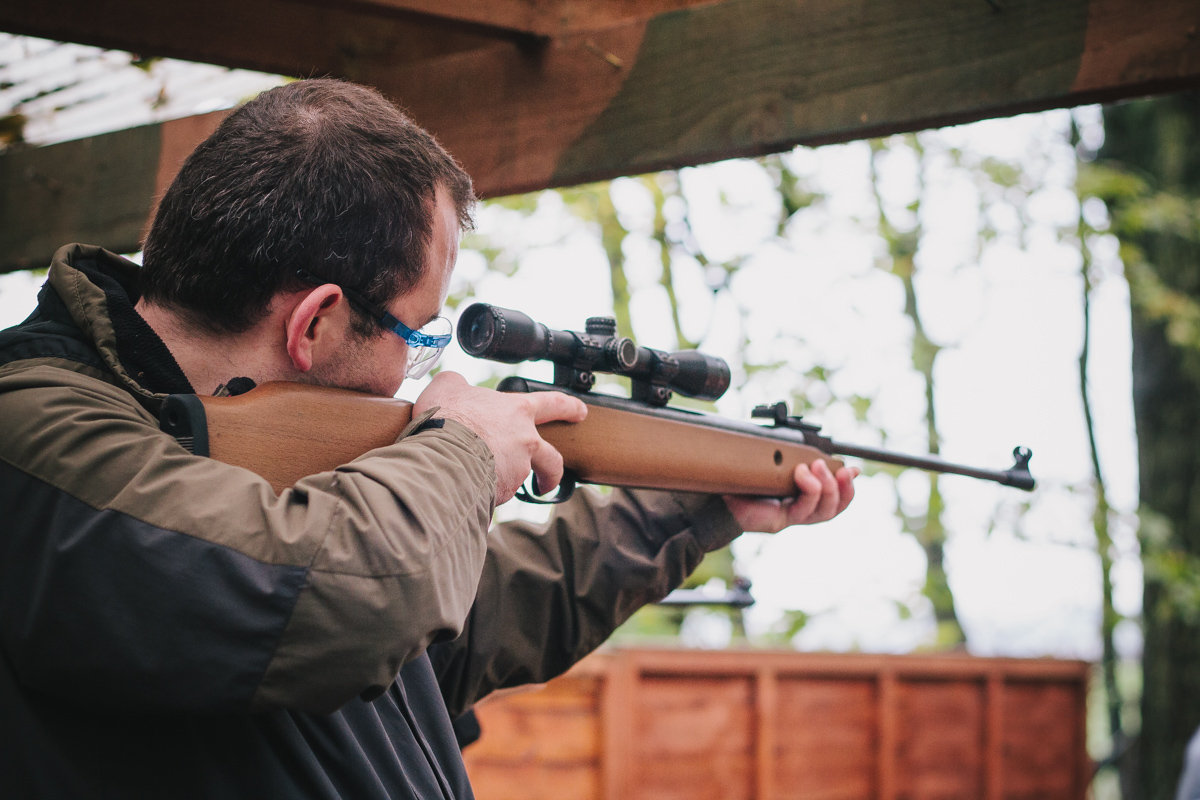Air rifles are becoming increasingly popular these days. From backyard target practice, to pest control, to hunting small game. They pack many advantages for your next outing. In this article we are going to dig into the different types of air rifles, the benefits of having one and hopefully help you decide which one is best for you.
In this article we will cover:
- Types of air rifles
- Space Requirements
- Noise level
- Cost of ammo
- .177 .22 or .25?
- Muzzle energy (ft lbs) vs feet per second (fps)
- Which caliber is right for me?
- Variable pump, break action or PCP?
Let’s get started
Types of air rifles

Variable Pump
The variable pump air rifle is a classic. Because the number of strokes can be varied and the air is under high pressure, variable pump rifles have the advantage of offering the shooter variable power. The forearm serves as the pump handle so there is no external device required but a considerable amount of work is required to pump the rifle eight or ten times (usually the maximum number recommended). These rifles tend to be short and light for the power they achieve. The major disadvantages of the variable pump as a hunting rifle is that reloading is slow and a great deal of movement is required during the process. Many hunters who use air rifles started with a variable pump and such a rifle is still a good choice.

Break Action
Break action rifles are widely used in hunting because they produce high velocity (1200+ fps). Firing a break action rifle in which a strong, heavy spring pushes a piston forward to compress air results in movement of the rifle before the pellet leaves the barrel. For this reason, many shooters find that it requires a lot more practice to shoot such rifles accurately. In general, break action rifles tend to be heavy, long, and noisy with a pronounced “twang” upon firing. Still, a great rifle in the hands of a skilled shooter.

Precharged Pneumatic (PCP)
The top of the line air rifles. Precharged pneumatic rifles offer vibration free firing, amazing accuracy, reloading is rapid and essentially noiseless and a multiple shot count. Precharged rifles are generally very powerful and also accurate as a result of their fixed barrel design. The fact that only air moves when the rifle is fired also contributes to its outstanding accuracy. These guns require you to fill them with either a tank or hand pump. They usualy hold between 2000 – 3000 psi. Consequently, PCP rifles are the choice of many serious airgun hunters, and the single shot Benjamin Discovery and the repeating bolt action Marauder are examples of this type of rifle.
Space requirements
Airguns do not require very much space to shoot safely. The majority of airguns on the market right now can fit almost any space needs. The lead pellets that air rifles shoot flatten upon impact and typically do not ricochet. Additionally the moderate power levels produced by airguns let them shine over firearms for hunting or taking care of pest critters in enclosed spaces like barns, feed silos, neighborhoods, etc. If you live in a crowded neighborhood, It’s probably not a good idea to take a shot at a raccoon in your dumpster at 2am with a 22 rimfire. You’ll want to grab the Marauder so the neighbors don’t hate you.
Noise level
With few exceptions, airguns are significantly quieter than firearms. The primary reason for this is that airgun velocities are typically sub-sonic, meaning the pellets are not breaking the sound barrier. In addition to not disturbing your neighbors, the decibel levels are low enough that the rifle report won’t cause hearing damage. Spring piston breakbarrel produce a dull slamming report similar to a nail gun. While PCP’s are much quieter. For example, the shrouded Benjamin Marauder is so quiet that the pellet impacting the target is louder than the gunshot. The low noise levels air rifles produce will not spook animals quite as much as firearms, which is great if you want to take multiple shots. A firearm shot through the woods is going to silence and scare away all the wildlife around. An air gun however will not. So while you are in the stand waiting on a deer you can snag all the little game without scaring any off.
Cost of ammo
It’s no secret that the cost of ammo has been on the rise. Fortunately that is not the case with air rifles. You can shoot and hunt with airguns for a fraction of the cost. A tin of match-quality domed pellets will cost some where around $12-17 for 500, depending on the caliber. The cost savings is significant.
.177 .22 or .25?
The caliber of the gun you need depends on a few different factors. The first question you should ask yourself is, “What will I be shooting?” If your plan is to punch paper than a .177 will be all you need. If you plan to take out a few pest starlings than a .177 or .22 will do. If you want to take on larger game like raccoons you will want to consider the .25. Now this isn’t to say you can’t shoot a raccoon with a well placed head shot using a .22, this just means with a .25, you will have a lot more knock down power down range.
Can a .177 or .22 be used for bigger game? Well that depends on just how skilled you are with your shot placement. Shot placement is much more crucial with smaller calibers. Now we’re not saying you can shoot a squirrel in the ass with a .25 and it will kill it. We’re saying you don’t have to be AS precise with a larger caliber. Lets remember that when hunting any game we always want the most humaine kills. Some people go with the .25 just to have the extra power if needed. Some will also argue that the .25 is more accurate at greater distances due to heavier pellets.
Muzzle energy (ft lbs) vs feet per second (fps)
Weve all seen those high numbers on the air rifle boxes claiming “1500 fps”. While this number may or may not be true, how much does it really matter? Think about this:
A .177 shooting an 8 grain pellet at 50 yards traveling at 1200 fps
compared to
A .25 shooting a 23 grain pellet at 50 yards traveling at 850 fps.
Which one is more effective in hunting?
If you said the .25, than you are absolutely right. Why is this? Two words: Muzzle energy.
What is foot pounds of muzzle energy?
Muzzle energy is the kinetic energy of a bullet as it is expelled from the muzzle. It is often used as a rough indication of the destructive potential of a given firearm or load. The heavier the bullet and the faster it moves, the higher its muzzle energy and the more damage it will do.
So even though the .177 pellet is traveling a lot faster than the .25, the .25 will still have a lot more knock down power due to the size of the pellet. It’s like throwing a golf ball at someone vs a bowling ball. The .25 really shines at further distances compared to the .177 and the .22. As a pellet travels it starts to lose muzzle energy. The .25 retains a lot more energy at further distances compared to the .177 and .22. Which means more destruction at longer yards.
So even though the “1500 fps” sounds fancy, it’s really not desirable. An 8 grain pellet traveling at 1200 fps is most likely not going to be accurate at all past 25 yards. The pellet is probably going to spiral out of control due to its light weight at high speeds. Actually, according to a study, the pellets used in testing to achieve such high fps numbers were light weight, lead-free pellets. So unless you’re shooting the side of a barn, don’t plan on hitting your target.
Which caliber is right for me?
Basically, if you plan on strictly hunting game, take the extra power and get the .25. You’ll know you’re prepared for whatever may come your way.
If you plan on hunting small game or punching paper in the backyard, the .177 or .22 will do. You can obviously punch paper with a .25, we just recommend it for hunting or pest control.
The .22 will work fine for hunting smaller game as well. We just recommend the .25 first because the majority of people, when using both a .25 and .22, reach for the .25 more than the .22 due to the extra power.
.177: Good for target practice, small game hunting, (pest birds, squirrels)
.22: Good for target practice, small game hunting, (pest birds, squirrels, rabbits)
.25: Good for small game hunting and large game hunting, (pest birds, squirrels, rabbits, raccoons)
Variable pump, break action or PCP?
Conclusion:
Hands down PCPs. Other types of air rifles can not compete with the accuracy and precision of a PCP. We aren’t saying that the variable pump and break actions aren’t good guns. We’re simplying saying if you are a serious air gunner/hunter and want to maximize your potential, a PCP is the best route.
While its not really budget friendly for everyone, the Benjamin Marauder is an amazing gun. It has been known to shoot up to over 100 yards and hit its target with ease (the .25 that is). But be prepared to spend around $800. That would include the gun itself, an okay scope and the hand pump. So while it may take some saving, it is definitely worth the wait. On our test with the M-rod (.25), we got some pretty awesome results. 5 shots, at 50 yards, left us with a grouping a dime would cover. Note, that we tested both the .22 and the .25. The .25 impressed us more because the accuracy from the .25 was significantly better than the .22 at anything beyond 25 yards.
If you just want to punch paper in the backyard with the kids or take out a few small pest, a break action or pump will work just fine. Break actions and variable pumps are fine for anything 25 yards and under. However, If you want to use a variable pump or break action and get dime size groupings at 50 yards and beyond, you might need a little bit of luck on your side.
If we forgot to add something to this article, feel free to let us know in the comments below. Tell us about your favorite air rifle and the results you got from it. Do you want us to write a review about something in particular? Mention it in a comment below.



Leave a comment